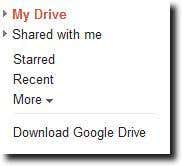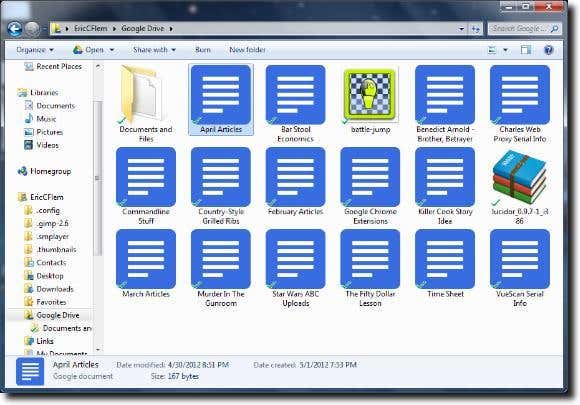- Back to Home »
- internet tricks , windows tricks »
- Getting Started With Google Drive For Windows
Posted by : Unknown
In many ways, new releases of Google products are viewed in a similar fashion to new releases from Apple. In other words, they are Big News. The newest of Google’s releases is the long-anticipated Google Drive, which allows users to upload documents to their Google Drive directly from the hard drive, and keep those documents synchronized with any other piece of hardware able to use the Google Drive software.
We took Google Drive out for a spin on our Windows 7 machine, to check out the synchronization between the Desktop and the Cloud. Here’s how our experience went.
The first step is to go to your Google Drive page, and click the “Download Google Drive” link.

Next, accept the Terms of Service.

You will now be asked to save a small file to your hard drive.

Once downloaded, go ahead and run the installer. It will need to be run as an Administrator.

The installer doesn’t require any user interaction, so go ahead and wait a bit, and you’ll eventually see verification that the installation completed.

Once you close this window (or completely on its own, if you wait to long to close the window), you’ll be asked to sign into your Google Drive account.

You’ll now see two different “Getting Started” screens. The first explains that a new folder will be created on your hard drive; this folder will be where your Google Drive documents are synchronized.

The second screen explains a bit more (including that all your Google Docs document will be synchronized), or lets you view Advanced Setup options.

If you choose to see the Advanced Setup options, you can choose which of your folders are synchronized locally (everything is synchronized by default), the location of the local Google Drive folder, and whether or not to synchronize your Google Docs documents. You may not want to synchronize them, as they will only be able to be viewed if offline; you can only edit them when connected to the Internet. You can also choose to start Google Drive automatically when you start your computer.

You’ll notice at this point that you have a new icon in your taskbar. Click the icon to view the following menu.

Here you can see the sync status, pause all syncing, view your Google Drive folder, go to Google Drive on the Web, and more. The “Preferences” option, just as a note, is the same as the Advanced Setup window we just viewed.
When you do visit your Google Drive folder, located at C:\Users\Username\Google Drive\ by default, you can see all your Google Drive documents. Anything fully synchronized will have the little green checkmark in the lower left corner.

All in all, the first release of Google Drive setup was pretty nice. As mentioned, Google Docs are only viewable in offline mode, not editable. This is too bad, as Google Chrome users can turn on offline functionality for Google Docs which includes editing, so this feels like a bit of a step back. Still, this is far advanced to simply using your Gmail account as a file system, and while there is no Linux client currently available (there is a Mac version available), one is apparently in the works. As said, it feels like a good first step, and the fact that it includes 5 GB of space and is completely free is a bonus as well. Time will tell how Google Drive progresses in the future, but for now it’s enough.
Categories
Blog Archive
-
2014
(79)
- August (1)
- June (5)
- May (20)
-
April
(43)
- Basic Terminal Commands For Linux
- Websites To Learn Computer Programming Languages
- Keyloggers And How To Be Safe From Keyloggers
- 6 Most Common Password Cracking Methods And Their ...
- What Is Phishing And How To Be Safe From Phishing ?
- Remove All Your Google Web History
- Hide Files Behind The Images
- Best Call Recorder for iPhone to Record Conversations
- jailbreak iDevice running iOS 7 using evasi0n7 [Wi...
- Add Folders and Software to My Computer in Windows...
- Make any Window transparent using a keyboard Short...
- Get Taskbar transparency in Windows 8
- View India in 360 with WoNoBo.com or with there An...
- How to Block Ads on Android Apps, Games and Browser’s
- Retrieve Your Wireless Network Security Key in Win...
- Use Alternate DNS Servers In Windows For Faster In...
- Use The Google Chrome Flash Plugin in Firefox in U...
- Encrypt Your Flash Drives In Ubuntu Linux Using Di...
- Use Google Chrome As The Default PDF Viewer In Ubuntu
- Change the GNOME Keyring Password For Easier Autom...
- Add a New Default Search Engine To Google Chrome W...
- Change the Default LightDM Background Image In Ubuntu
- Turn Off The Startup Sound In Windows Vista and Wi...
- Find, View and Analyze BSOD Dump Files
- Disable Aero (Permanently or Temporarily) in Windo...
- Change the Windows 7 Login Image without Editing t...
- Getting Started With Google Drive For Windows
- Use Google Web Fonts in the Google Docs Word Proce...
- Merge Two Partitions in Windows
- Change Where Chrome Downloads Files To
- View Photo EXIF Metadata on iPhone, Mac, and Windows
- Track Your iPhone, iPad, and Mac Computer
- Remove Duplicate Contacts on iPhone
- Create a Multiple Operating System Bootable USB Drive
- Guide to Taking Screenshots in Windows 8
- 99 Ways to Make Your Computer Fast
- Tips to Avoid Installing Browser Extensions with A...
- Some methods to Make Sure No One is Monitoring You...
- Get back the corrupted files in pendrive without a...
- Download YouTube videos using VLC media player wit...
- HIDE A FOLDER IN NOKIA PHONE WITHOUT ANY SOFTWARE
- Some Common Internet Error Codes With Meanings
- CCleaner is Now Available for Android
- March (10)








